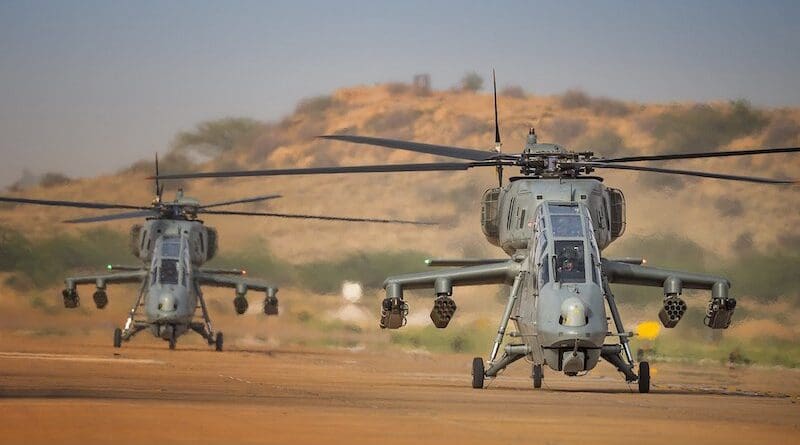From Apache To LCH: Modernizing Army Aviation For Enhanced Combat Capability – Analysis
By Ashu Mann
In the theatre of 21st-century warfare, air mobility is not just an enabler. It is a decisive force multiplier. For the Indian Army, which faces simultaneous operational imperatives along rugged Himalayan heights in the north and vast deserts in the west, the role of combat aviation is central to achieving deterrence, speed, and precision.
The recent modernisation of Army Aviation, pivoting on the induction of high-tech platforms like the AH-64E Apache and indigenously built Light Combat Helicopter (LCH), is not a mere hardware upgrade; it is a structural transformation aligned with India’s broader warfighting doctrine.
The Indian Army’s aviation wing, once limited to observation and liaison roles, is now on the cusp of becoming a formidable aerial strike and surveillance force. The induction of six Boeing AH-64E Apache attack helicopters, as per a hybrid contract signed under Foreign Military Sales (FMS) and Direct Commercial Sale (DCS) in 2020, is a landmark move. These Apaches, outfitted with Longbow fire control radars, Hellfire missiles, and Stinger air-to-air missiles, will provide a decisive edge in both high-intensity conflict and counter-insurgency operations. Though their delivery has been delayed due to critical component shortages in the United States, the Indian Army and the Ministry of Defence (MoD) have proactively engaged with the U.S. Department of Defense (DoD) to expedite timelines.
The Apache’s lethal precision strike capabilities, battlefield survivability, and night-fighting proficiency are vital in India’s contested zones. Unlike the Indian Air Force’s fleet, these helicopters will be operated directly by the Army, ensuring rapid response and decentralised command at the tactical level, especially in the northern sector.
Yet, what truly signals India’s strategic foresight is the induction of the HAL Light Combat Helicopter (LCH). Designed and developed indigenously by Hindustan Aeronautics Limited, the LCH has been tailored for Indian battlefield conditions, especially high-altitude operations in Siachen, Eastern Ladakh, and Arunachal Pradesh. As of 2024, 15 Limited Series Production (LSP) LCHs are in the process of being inducted into Army Aviation. These multi-role platforms can execute air defence, anti-armour, counter-insurgency, and urban warfare missions with remarkable agility. Armed with 70mm rockets, Mistral air-to-air missiles, and 20mm turret guns, the LCH boasts a robust airframe optimised for low-visibility and high-survivability missions.
The LCH is not just a platform—it is a statement of India’s push for Aatmanirbharta (self-reliance) in defence manufacturing. More critically, it aligns with the Army’s plan to have an integrated aviation ecosystem comprising attack, utility, reconnaissance, and unmanned platforms, all with indigenous roots. This is particularly essential in a future battlefield environment shaped by grey-zone threats, high-altitude standoffs, and the need for quick force projection.
To complement this high-end capability, the Army is progressing toward inducting Light Utility Helicopters (LUH) for reconnaissance and logistics roles. These HAL-designed helicopters will eventually replace the ageing Cheetah and Chetak fleets, offering modern avionics, greater range, and safer operations in difficult terrain. Their entry is crucial in supporting forward deployments in inaccessible posts where ground movement is restricted by terrain and climate.
Strategically, the timing of these acquisitions reflects a realist understanding of India’s evolving threat matrix. China’s aggressive infrastructure development and enhanced aviation deployments across the Tibetan plateau, and Pakistan’s continued reliance on rapid mobilisation doctrines, necessitate that India maintains a credible deterrent with vertical manoeuvre capabilities. Attack helicopters like Apache and LCH bridge the firepower gap between artillery and fast jets, offering surgical lethality in contested airspaces.
On the operational side, Army Aviation’s expansion is also linked to the concept of Integrated Battle Groups (IBGs). These lean, agile, and tech-enabled formations require embedded aviation support for surveillance, close air support, troop insertion, casualty evacuation, and precision strikes. The doctrinal shift is clear: Indian forces must respond swiftly and decisively across all altitudes and terrains, with aviation at the core.
As India prepares for a complex threat environment defined by high-altitude standoffs, grey-zone incursions, and cross-domain operations, the modernisation of Army Aviation is not just timely but indispensable. From the thunder of Apaches to the precision of Indigenous LCHs, India’s skies will remain guarded not only by advanced machines but also by a doctrine that places mobility, firepower, and speed at the heart of deterrence and victory.

